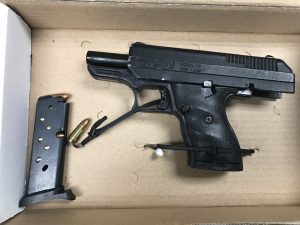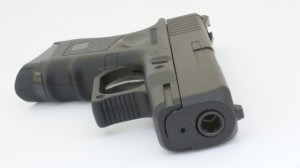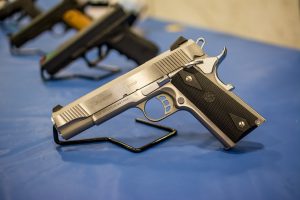 Last week two Maryland men in their late 20s appeared in federal court on gun charges, and both will end up serving several years in prison. The first case was heard last Thursday in the Greenbelt federal courthouse, where a 29-year-old man from Suitland pled guilty to two counts of felon in possession of a firearm. The Prince George’s County man had been convicted of attempted distribution of cocaine in Washington D.C. back in 2014, which made him permanently ineligible to possess a firearm in all U.S. jurisdictions. Unfortunately for the defendant, law enforcement subsequently found him in possession of a firearm on at least two recent occasions. In June of 2020 Prince George’s County Police conducted a search of the defendant’s home pursuant to a warrant, and recovered a .40 caliber handgun, ammunition and CDS including buprenorphine and naloxone. These prescription drugs are used to treat heroin and other opioid addictions, but can be used as illicit substances. After being advised of his Miranda rights the defendant admitted that the firearm was in his possession.
Last week two Maryland men in their late 20s appeared in federal court on gun charges, and both will end up serving several years in prison. The first case was heard last Thursday in the Greenbelt federal courthouse, where a 29-year-old man from Suitland pled guilty to two counts of felon in possession of a firearm. The Prince George’s County man had been convicted of attempted distribution of cocaine in Washington D.C. back in 2014, which made him permanently ineligible to possess a firearm in all U.S. jurisdictions. Unfortunately for the defendant, law enforcement subsequently found him in possession of a firearm on at least two recent occasions. In June of 2020 Prince George’s County Police conducted a search of the defendant’s home pursuant to a warrant, and recovered a .40 caliber handgun, ammunition and CDS including buprenorphine and naloxone. These prescription drugs are used to treat heroin and other opioid addictions, but can be used as illicit substances. After being advised of his Miranda rights the defendant admitted that the firearm was in his possession.
The defendant was charged with possession with intent to distribute, and offenses related to false prescriptions. He was also charged with possession of a firearm by a convicted felon, illegal possession of a regulated firearm and possession not marijuana. The possession with intent (PWID) charge was of the variety that comes with a 5-year maximum penalty rather than the 20-year penalty that narcotics cases carry. Despite the severity of the charges, the defendant was released on bond one day after his arrest at a district court bail review. The defendant’s lack of prior violent criminal history likely played a role in his release, as did his ties to Prince George’s County. However, less than 4 months after his release he was arrested again on gun charges. This time the arrest took place in Washington D.C., and was the result of a traffic stop that turned into a foot chase. After the defendant was pulled over for running a stop sign, police discovered that he had an active Maryland circuit court arrest warrant stemming from the PG County gun and drug case. The U.S. Attorney’s press release does not specify why the defendant had the warrant, but it was likely for violating a condition of his pre-trial release or for missing court. After the defendant was confronted about the warrant, he took off on foot in attempt to fell from police. Officers then caught the defendant and located a loaded .45 caliber handgun in his jacket pocket. The feds stepped in not long after his arrest on the D.C. case, and charged both cases together in the Greenbelt federal court. The PG circuit court case was later dismissed along with the D.C. case, and now the defendant faces up to 10-years in prison on each count when he is sentenced in November of this year.
The second case occurred just one day later in the Baltimore City federal courthouse, where a 28-year-old Baltimore man was sentenced to 57 months in federal prison, followed by 3 years of supervised release for one count of felon in possession of a firearm. This defendant was originally arrested on state charges after being arrested at the end of 2019. According to the plea, Baltimore Police officers observed the defendant conduct a drug transaction and then gave chase. The defendant fled on his bicycle and eventually on foot, but officers caught up with him and found a loaded 9 mm handgun as well as cocaine and fentanyl packaged for sale. He was charged with possession of a firearm in a drug trafficking crime, illegal possession of a firearm, PWID narcotics and other offenses, though the state case was dismissed after the feds decided to prosecute. The defendant was prohibited from possessing guns due to felony convictions from 2015 that involved narcotics distribution.
 There was significant movement last week in highly publicized state measures to curb the circulation of unserialized firearms commonly known as ghost guns. Both the House and Senate preliminarily approved legislation that would eventually ban the sale and ownership of the untraceable firearms in Maryland. These untraceable guns have been a major point of contention for police and law makers alike, and have undoubtedly contributed to an increased number of gun crimes over the past couple of years. The gun components are often made of polymer or other materials that are easy to fashion yet strong enough to withstand the explosion of a cartridge being fired, and are relatively cheap. Basically, anyone with internet access and a Venmo account could order the components to make a working firearm in a matter of hours. Therefore, it’s no surprise that a state like Maryland that already has some of the toughest gun laws in the country is making serious moves to eliminate untraceable firearms.
There was significant movement last week in highly publicized state measures to curb the circulation of unserialized firearms commonly known as ghost guns. Both the House and Senate preliminarily approved legislation that would eventually ban the sale and ownership of the untraceable firearms in Maryland. These untraceable guns have been a major point of contention for police and law makers alike, and have undoubtedly contributed to an increased number of gun crimes over the past couple of years. The gun components are often made of polymer or other materials that are easy to fashion yet strong enough to withstand the explosion of a cartridge being fired, and are relatively cheap. Basically, anyone with internet access and a Venmo account could order the components to make a working firearm in a matter of hours. Therefore, it’s no surprise that a state like Maryland that already has some of the toughest gun laws in the country is making serious moves to eliminate untraceable firearms.
 There was significant movement last week in highly publicized state measures to curb the circulation of unserialized firearms commonly known as ghost guns. Both the House and Senate preliminarily approved legislation that would eventually ban the sale and ownership of the untraceable firearms in Maryland. These untraceable guns have been a major point of contention for police and law makers alike, and have undoubtedly contributed to an increased number of gun crimes over the past couple of years. The gun components are often made of polymer or other materials that are easy to fashion yet strong enough to withstand the explosion of a cartridge being fired, and are relatively cheap. Basically, anyone with internet access and a Venmo account could order the components to make a working firearm in a matter of hours. Therefore, it’s no surprise that a state like Maryland that already has some of the toughest gun laws in the country is making serious moves to eliminate untraceable firearms.
There was significant movement last week in highly publicized state measures to curb the circulation of unserialized firearms commonly known as ghost guns. Both the House and Senate preliminarily approved legislation that would eventually ban the sale and ownership of the untraceable firearms in Maryland. These untraceable guns have been a major point of contention for police and law makers alike, and have undoubtedly contributed to an increased number of gun crimes over the past couple of years. The gun components are often made of polymer or other materials that are easy to fashion yet strong enough to withstand the explosion of a cartridge being fired, and are relatively cheap. Basically, anyone with internet access and a Venmo account could order the components to make a working firearm in a matter of hours. Therefore, it’s no surprise that a state like Maryland that already has some of the toughest gun laws in the country is making serious moves to eliminate untraceable firearms.
 Criminal Defense Lawyer Blog
Criminal Defense Lawyer Blog







